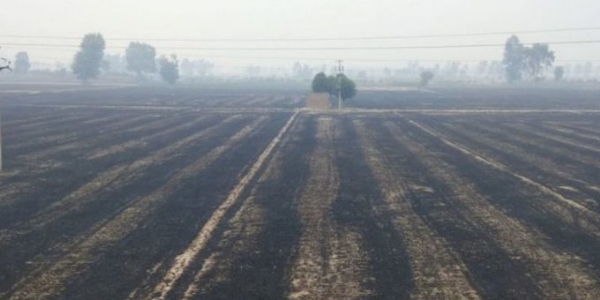The real reason behind Delhi's pollution
Come October end and early November, coincident with Diwali, the peaking air pollution causes untold miseries to crores of children, asthmatic patients, and vulnerable senior citizens with severe respiratory illnesses and throat and eye infections.
Total Views |
New Delhi, Nov 03: During the last few years, pollution in Delhi and north India has caused the most alarming public health crisis impacting over 30 crore Indians.

Come October end and early November, coincident with Diwali, the peaking air pollution causes untold miseries to crores of children, asthmatic patients, and vulnerable senior citizens with severe respiratory illnesses and throat and eye infections.
This year, pollution levels have reached over 20 times the safe limit, forcing people indoors and halting construction activities and vehicular restrictions. The prime reason for this massive air pollution in north India is attributed to the indiscriminate stubble burning by farmers of Punjab and Haryana. However, this problem of air pollution due to the burning of crop residue has become alarming, particularly in the last 7-8 years. But the farmers of Punjab and elsewhere have been burning the crop stubble for centuries to clear the Kharif crop residue from their fields. So why has it become the prime cause of air pollution in recent years? Has something changed? Yes. The change happened due to a forced change in paddy sowing season due to the implementation of the Punjab Preservation of Subsoil Water Act 2009. This legislation prohibits farmers from sowing paddy before 10 May and transplant paddy before June 16 every year. Violation invites penalties of Rs 10,000 per hectare and the nursery's destruction at the farmer’s expense with no legal or civil remedy. Traditionally, farmers harvest the Rabi crop by March-end and early April, and the paddy transplanting is complete by May 15. However, this Punjab Act has delayed the sowing season by over a month. Paddy requires 120 days after transplant and this delay has resulted in the harvest period from mid-September to mid-October. Haryana, too, has copied the Act and passed similar legislation. This has further resulted in a delay in the burning of stubble by a month. For ages, the stubble of the Kharif crop has been burnt but the strong retreating monsoon winds moving towards the Bay of Bengal carry away the pollutants quickly with minor impact in north India. However, the delay of a month in the sowing, harvest, and the burning cycle is causing severe air pollution as by the time the crop stubble is burnt at October-end, the wind pattern has completely changed and there is no retreating monsoon wind to clean up the atmosphere. By that time another weather phenomenon sets in. By mid-October, a series of low-pressure systems develop in the Bay of Bengal, causing rainfall in the coastal regions and pushing huge water vapor content into the upper troposphere which slowly drifts into the Northern plains leading to early winter dew. The month’s delay leads to a giant smoke-haze-moisture sphere as the water vapor does not allow smoke to rise. Further, a typical anti-cyclonic wind pattern results in stand-still weather, leading to high levels of pollution throughout the winter in north India.
The pollution level changes slightly according to wind speed and western disturbances patterns but never recovers to safe limits during winter. The traditional practices were replaced by the Punjab government by the enactment of the Punjab Preservation of Subsoil Water Act allegedly on the report of USAID with the aim to promote a hybrid maize variety by agro giant Monsanto. While the National Green Tribunal and the Supreme Court have issued slews of measures relating to vehicular and industrial pollution and regulating the bursting of Diwali crackers to curb the growing air pollution, it would be in the fitness of things to have a hard look at the 2009 Punjab state legislation.

